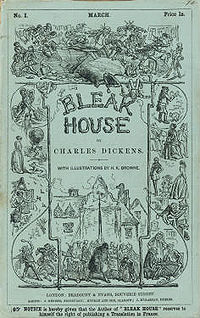Recently, I have been reading some of Charles Dickens’ novels. The guy could write! His books are funny, atmospheric, rich in detail, both personal and geographic, filled with wonderfully named characters—Harold Skimpole, Bucket, Sarjeant Buzfuz, and Mrs. Jellyby—and insightful. My most recent read is Bleak House, which contains two splendid references to geology.

The first is in the amazing opening paragraph.
“London. Michaelmas term lately over, and the Lord Chancellor sitting in Lincoln’s Inn Hall. Implacable November weather. As much mud in the streets as if the waters had but newly retired from the face of the earth, and it would not be wonderful to meet a Megalosaurus, forty feet long or so, waddling like an elephantine lizard up Holborn Hill. Smoke lowering down from chimney-pots, making a soft black drizzle, with flakes of soot in it as big as full-grown snowflakes—gone into mourning, one might imagine, for the death of the sun. Dogs, undistinguishable in mire. Horses, scarcely better; splashed to their very blinkers. Foot passengers, jostling one another’s umbrellas in a general infection of ill temper, and losing their foot-hold at street-corners, where tens of thousands of other foot passengers have been slipping and sliding since the day broke (if this day ever broke), adding new deposits to the crust upon crust of mud, sticking at those points tenaciously to the pavement, and accumulating at compound interest.”
Megalosaurus had entered the lexicon on February 20, 1824 at a Geological Society of London meeting, when William Buckland described fossil teeth and bones from a carnivorous reptile at least forty feet long and weighing as much as an elephant. In honor of its larger-than-life size, at least larger than any known land animal, Buckland named it Megalosaurus, the Great Lizard. His description was the first ever of what would soon be called a dinosaur.
Few probably truly appreciated Megalosaurus until two years after the first publication of Bleak House. On July 10, 1854, at the grand reopening of the Crystal Palace, the public got to see the world’s first life-sized models of dinosaurs, although very few people called them that. The most common descriptors for the models—Megalosaurus, Iguanodon, and Hylaeosaurus—were antediluvian beasts or antediluvian monsters. Benjamin Waterhouse Hawkins’ display was the opening of our long term love affair with dinosaurs.

The second reference is even better, at least for my focus on building stones:
“People objected to Professor Dingo when we were staying in the north of Devon after our marriage,” said Mrs. Badger, “that he disfigured some of the houses and other buildings by chipping off fragments of those edifices with his little geological hammer. But the professor replied that he knew of no building save the Temple of Science. The principle is the same, I think?”
I am not recommending that everyone go out and follow in Professor Dingo’s footsteps but it is noble thought and I was glad to learn that my passion for building stone has had a long and illustrious history. I have to admit though that I have been known to peel up layers of weakened sandstone and even splash vinegar on a building or two to test whether it was made of limestone or sandstone. I also joke about whacking off a building chunk or two when leading building stone walks but want to make it clear that I have never done so…yet.